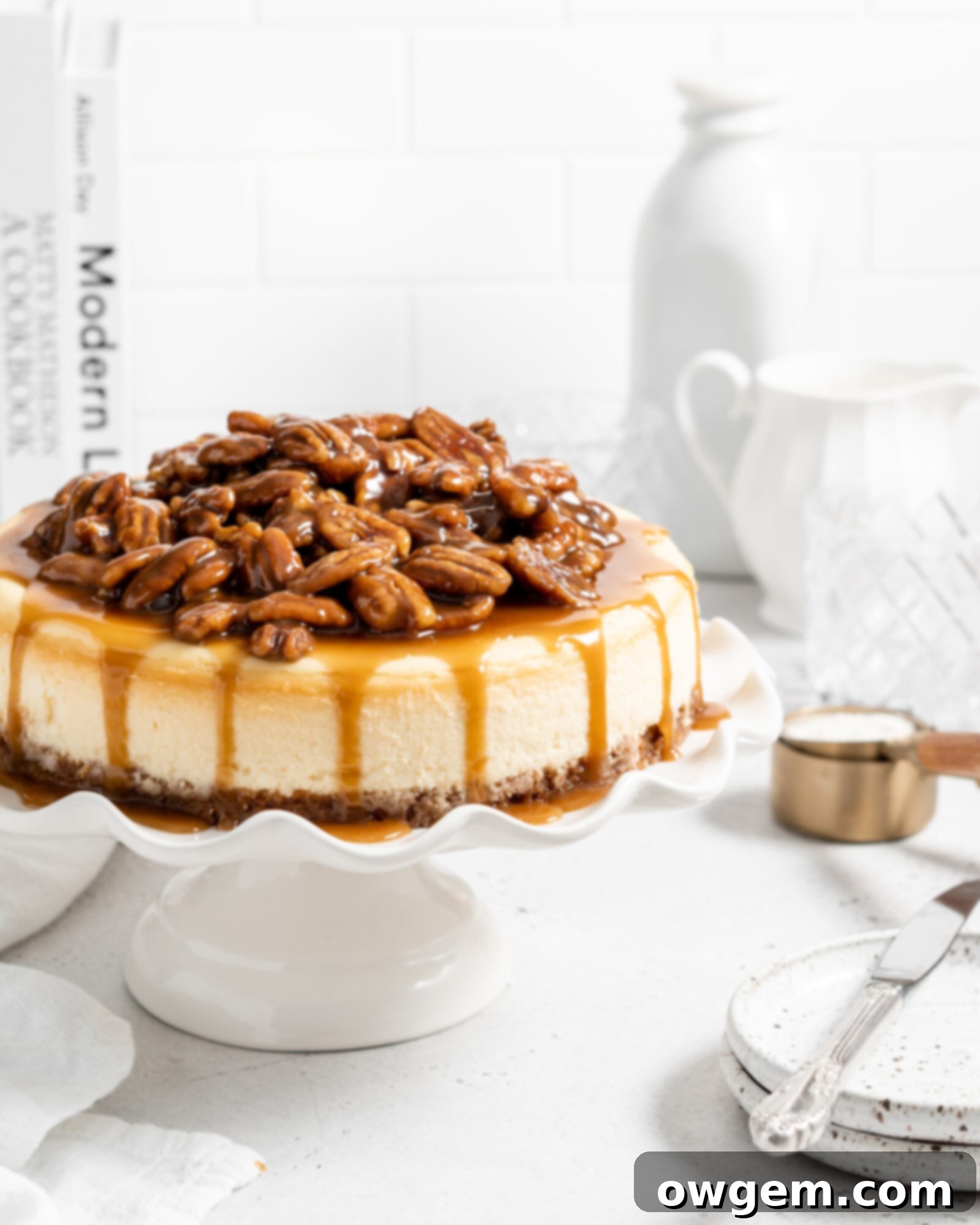Indulge in the Ultimate Caramel Pecan Cheesecake: A Velvety, Decadent Dessert
Prepare to be swept away by this truly extraordinary dessert: a rich, velvety cinnamon cheesecake crowned with an unbelievably luscious caramel pecan topping. This isn’t just any cheesecake; it’s a culinary masterpiece, boasting a perfectly soft and creamy texture that melts in your mouth, balanced with a delightfully sweet and mildly tart flavor. But the real showstopper? That thick, warm, and profoundly sweet caramel pecan topping that transforms every bite into a dream. If you’re searching for a dessert that delivers both elegance and comforting indulgence, your quest ends here.
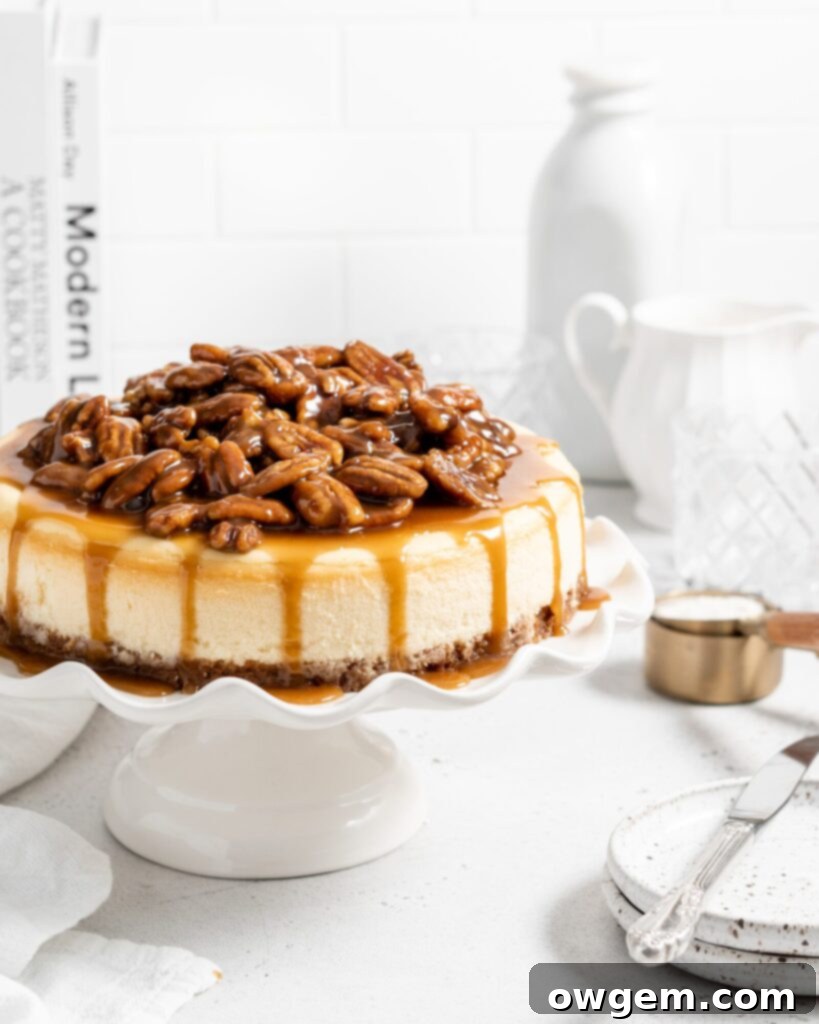
Why This Caramel Pecan Cheesecake Will Become Your New Favorite
Rich and creamy texture: At the heart of this recipe is a cheesecake base that is exceptionally smooth and luxurious. We achieve this velvety texture by carefully selecting and preparing the ingredients, ensuring each bite is a testament to the classic cheesecake experience but elevated with subtle cinnamon notes. It’s the kind of richness that satisfies without being overly heavy, making it a perfect end to any meal.
Decadent caramel pecan topping: The crown jewel of this dessert is undoubtedly its caramel pecan topping. Imagine a warm, gooey, deeply flavored caramel sauce brimming with toasted pecans, poured generously over a chilled cheesecake. The contrast in temperatures and textures — the creamy cool cheesecake against the warm, nutty, and sticky-sweet topping — creates an unparalleled sensory experience. It’s truly an irresistible combination that makes this cheesecake unforgettable.
A dream for pecan pie lovers: For those who adore the sweet, nutty, and buttery goodness of a classic pecan pie, this cheesecake offers a delightful twist. It masterfully combines the beloved flavors and textures of pecan pie with the smooth, tangy richness of cheesecake. It’s like getting the best of both worlds in one magnificent dessert, offering all the comforting notes you crave in a sophisticated new form.
Classic buttery graham cracker crust: Every great cheesecake starts with a foundation, and ours features a buttery, slightly crisp, and perfectly sweet graham cracker crust. This simple yet essential component provides a wonderful textural contrast to the creamy filling. It’s incredibly easy to prepare, requiring just a few ingredients and minimal effort, setting the stage for the decadent layers above.
The ultimate make-ahead dessert: One of the best aspects of this caramel pecan cheesecake is its suitability for preparing in advance. Cheesecakes, by nature, benefit immensely from extended chilling time, allowing their flavors to meld and their texture to firm up beautifully. You can easily bake this cheesecake hours beforehand, or even the night before, making it an ideal stress-free dessert for dinner parties, holidays, or any special occasion. Simply add the warm topping just before serving, and prepare for applause!
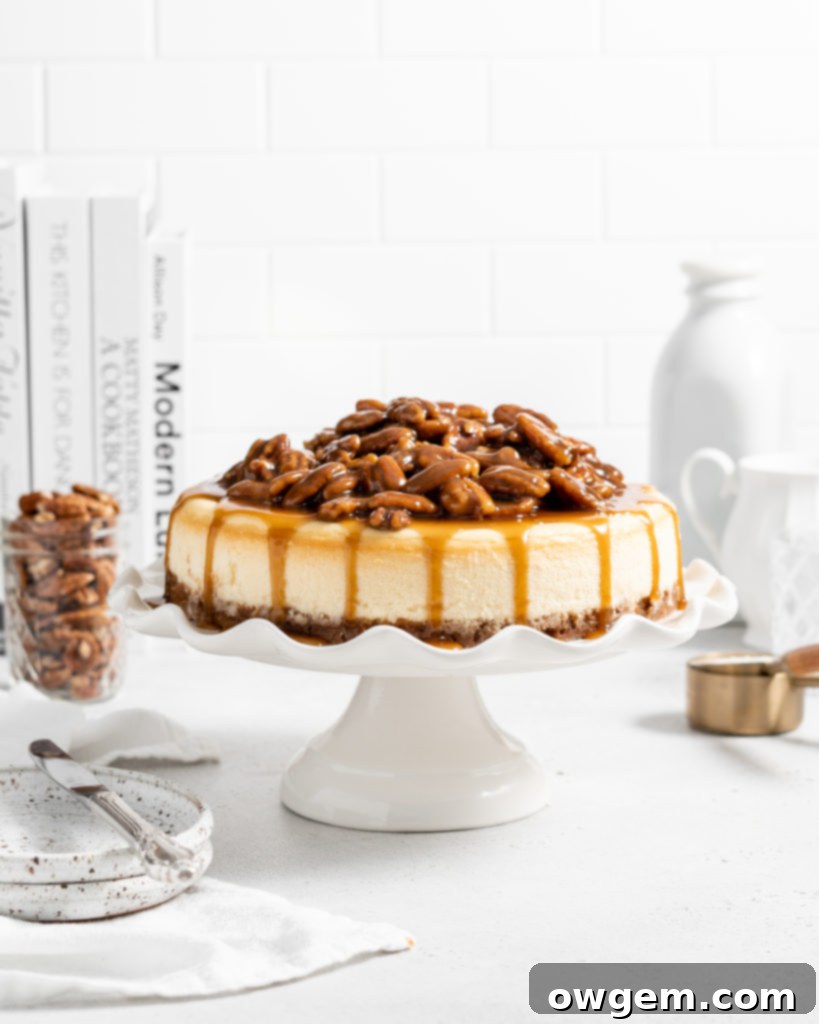
Key Ingredients for a Perfect Cheesecake
To achieve the exquisite flavor and texture of this caramel pecan cheesecake, the quality and preparation of your ingredients are paramount. Here’s a closer look at the stars of our show:
Cream Cheese: This is the foundation of any great cheesecake, and for ours, full-fat cream cheese at room temperature is absolutely non-negotiable. Full-fat varieties provide the necessary richness and structure, while cream cheese softened to room temperature ensures a smooth, lump-free batter that incorporates air evenly and bakes beautifully. Cold cream cheese can lead to a lumpy texture and overmixing, which can cause cracks.
Sour Cream: Another crucial full-fat dairy component, sour cream adds a subtle tang that balances the sweetness of the cheesecake and contributes significantly to its ultra-creamy, velvety texture. It also helps prevent cracking by adding moisture and fat, making the cheesecake more tender and less prone to drying out during baking.
Heavy Cream: This versatile ingredient plays a dual role in our recipe. Within the cheesecake batter, heavy cream enhances the richness and contributes to the luxuriously smooth consistency. In the caramel pecan topping, it’s essential for creating that thick, pourable, and incredibly decadent sauce, giving it body and gloss.
Graham Cracker Crumbs: The base of our crust. The quality of your graham cracker crumbs can make a noticeable difference. Opt for a good quality brand, as some cheaper varieties can produce an overly oily or greasy crust. A good crumb provides the perfect balance of sweetness and crunch, forming a sturdy foundation for the cheesecake.
Eggs: Eggs are vital for structure and binding in cheesecake, helping it set into a firm yet tender custard. The addition of extra egg yolks specifically enhances the richness, deepens the yellow hue, and contributes to that desirable dense, creamy mouthfeel, making the cheesecake even more indulgent.
Corn Starch: A secret weapon for cheesecake perfection! A small amount of cornstarch acts as a stabilizer, helping the cheesecake firm up and set more reliably. It also plays a role in preventing cracks, as it strengthens the protein structure of the batter, making it more resilient to temperature changes during baking and cooling.
Pecans: These provide the “pecan” in our caramel pecan cheesecake. For the ultimate pecan pie-like flavor and aroma, take the extra step to toast these bad boys. Toasting brings out their natural oils, intensifying their nutty flavor and adding a wonderful depth that complements the sweet caramel beautifully.
Brown Sugar: The star ingredient for our rich caramel sauce. Brown sugar, with its molasses content, lends a deeper, more complex flavor to the caramel compared to white sugar. It creates a rich, buttery, and slightly smoky sweetness that is absolutely essential for the decadent pecan topping.
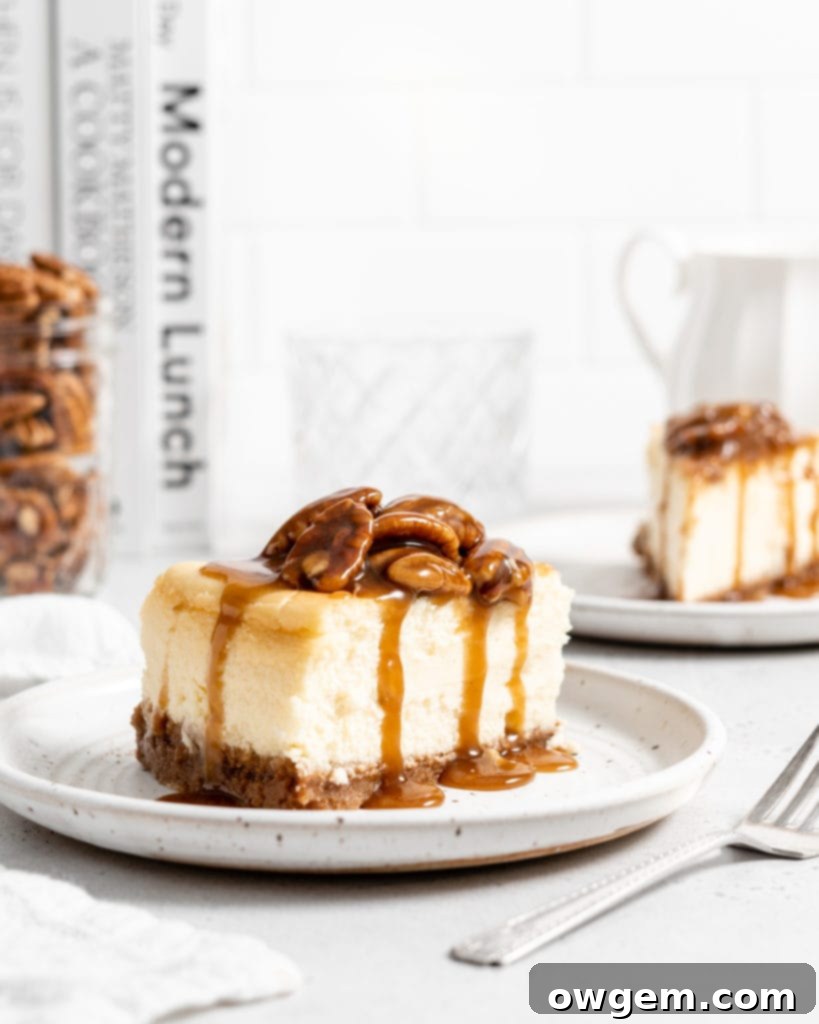
Step-by-Step Guide: Crafting Your Caramel Pecan Cheesecake
Creating a showstopping cheesecake might seem intimidating, but by following these detailed steps, you’ll achieve a perfect, crack-free, and incredibly delicious dessert every time.
1. Make the graham cracker crust: Begin by preheating your oven and preparing your ingredients. In a medium bowl, combine the finely crushed graham cracker crumbs with white sugar. Whisk them together thoroughly to ensure the sugar is evenly distributed. Next, pour in the melted unsalted butter. Using your hands or a fork, toss the mixture until every crumb is well coated and the consistency resembles wet sand. This ensures a cohesive crust.
2. Bake and cool the crust: Lightly grease a 9-inch or 10-inch springform pan with baking spray. Transfer the crumb mixture into the prepared pan. Using the bottom of a flat-bottomed glass or a measuring cup, firmly press the crust mixture evenly into the bottom and slightly up the sides of the pan. Compacting it well is key to preventing a crumbly crust. Bake the crust for about 10 minutes, then remove it from the oven and allow it to cool completely to room temperature before adding the filling. This step is crucial to prevent a soggy crust.
3. Beat cream cheese until smooth: In the bowl of a stand mixer fitted with a paddle attachment (or using a large bowl and a hand mixer), add your well-softened, room-temperature full-fat cream cheese. Beat it on low speed for about 2-3 minutes until it becomes exceptionally creamy and smooth, with no lumps visible. Avoid beating on high speed, as this incorporates too much air, which can lead to cracks in your finished cheesecake.
4. Add sugar, cinnamon, salt, and vanilla: Once the cream cheese is smooth, add the white sugar, fragrant cinnamon, kosher salt, and pure vanilla extract to the bowl. Continue beating on low speed until all these ingredients are thoroughly combined, creating a homogeneous, smooth, and creamy mixture. Scrape down the sides of the bowl as needed to ensure everything is fully incorporated.
5. Incorporate eggs gradually: This is a critical step for a crack-free cheesecake! Add the large eggs and egg yolks one at a time to the batter, beating on low speed just until each egg is fully incorporated before adding the next. This gentle approach prevents overmixing, which can introduce too much air into the batter, leading to an airy, uneven texture and potential cracks during baking. Scrape down the bowl after each addition to ensure even mixing.
6. Finish with cream, sour cream, and cornstarch: After all the eggs are perfectly integrated, gently mix in the heavy cream and sour cream on low speed until the batter looks smooth, well-combined, and uniform. Finally, add the cornstarch and continue beating on low until it is completely combined into the batter. The cornstarch acts as a stabilizer, helping the cheesecake achieve a perfect set and reducing the risk of cracking.
7. Prepare for water bath and bake: Take two large pieces of heavy-duty aluminum foil and tightly wrap them around the base and up the sides of your springform pan. This creates a protective barrier against water seeping in during the water bath. Pour the cheesecake filling over your cooled graham cracker crust in the springform pan. Carefully place the foil-wrapped cheesecake pan into a larger roasting pan. Now, carefully pour boiling water into the roasting pan, ensuring the water level comes about halfway up the sides of the cheesecake pan. This water bath is essential for gentle, even cooking and a silky-smooth, crack-free cheesecake. Transfer the entire roasting pan with the cheesecake into your preheated oven to bake.
8. Cool cheesecake slowly: Once the cheesecake has finished baking (it should still have a slight jiggle in the center), turn off the oven but leave the cheesecake inside with the oven door slightly ajar. Allow it to cool in the cracked oven for approximately 1 to 1.5 hours. This gradual cooling process is paramount to prevent sudden temperature changes that cause the cheesecake to contract rapidly and crack. After this period, remove the cheesecake from the oven and the water bath, and let it cool completely to room temperature on a wire rack on your counter. Once at room temperature, cover it tightly with plastic wrap and transfer it to the refrigerator to chill and set overnight, or for at least 6-8 hours. Patience here is key for the perfect texture.
9. Top warm caramel pecan sauce at serving time: After your caramel pecan cheesecake has fully chilled and set in the refrigerator, carefully remove it from the springform pan. Just before serving, gently warm the prepared caramel pecan sauce (instructions below). Pour the warm, glistening sauce generously over the top of the chilled cheesecake. Slice with a hot knife and serve immediately for an unforgettable dessert experience!
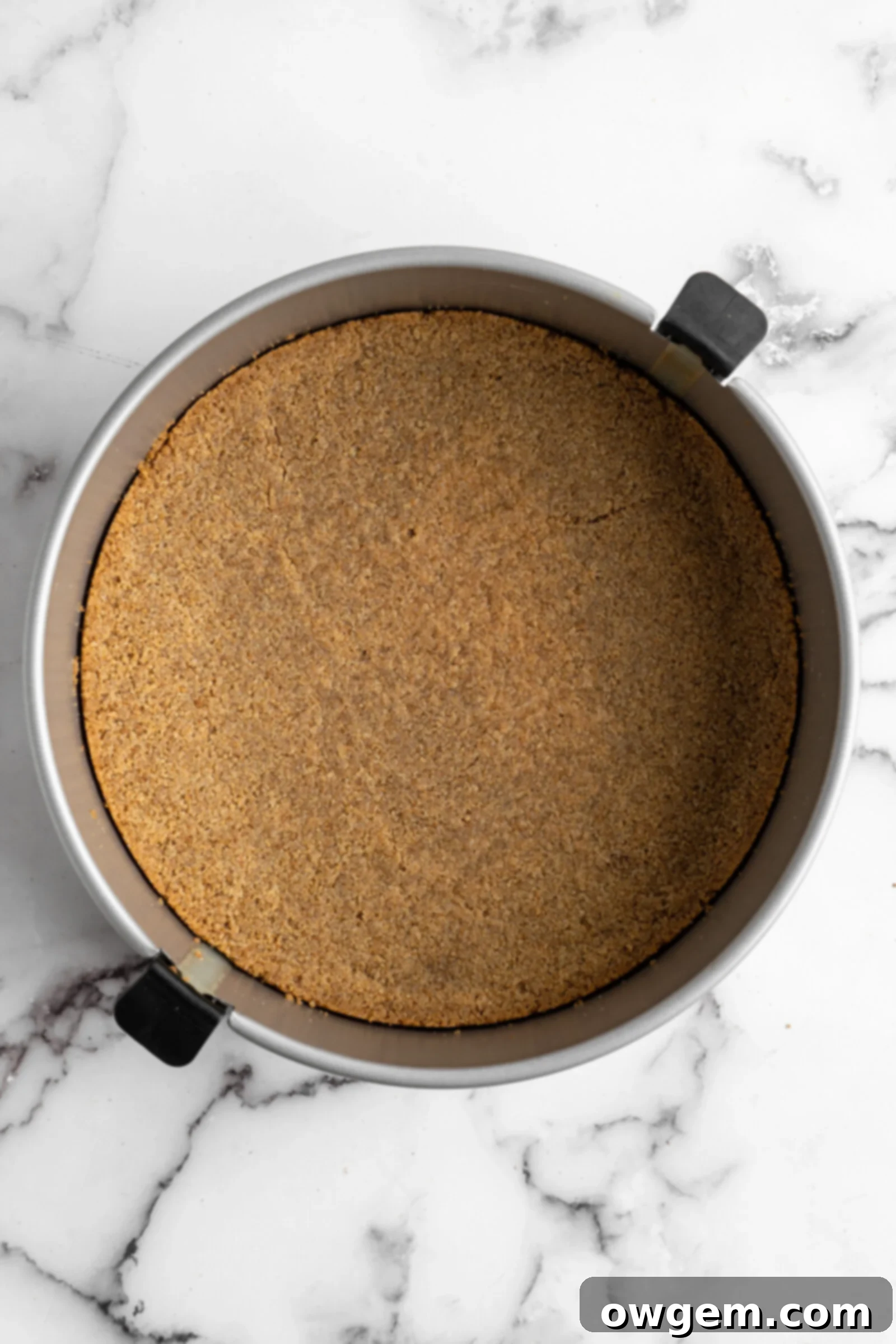
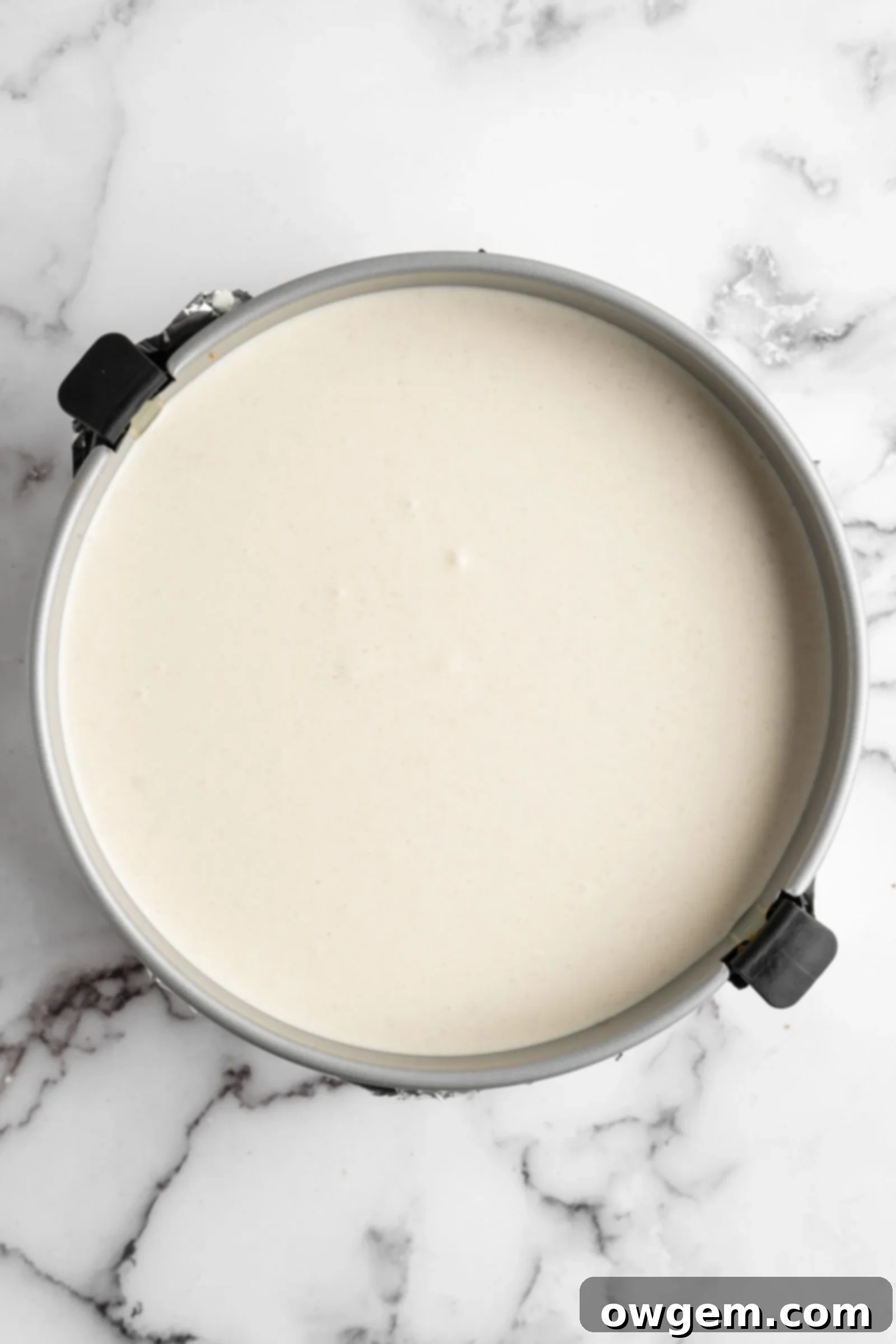
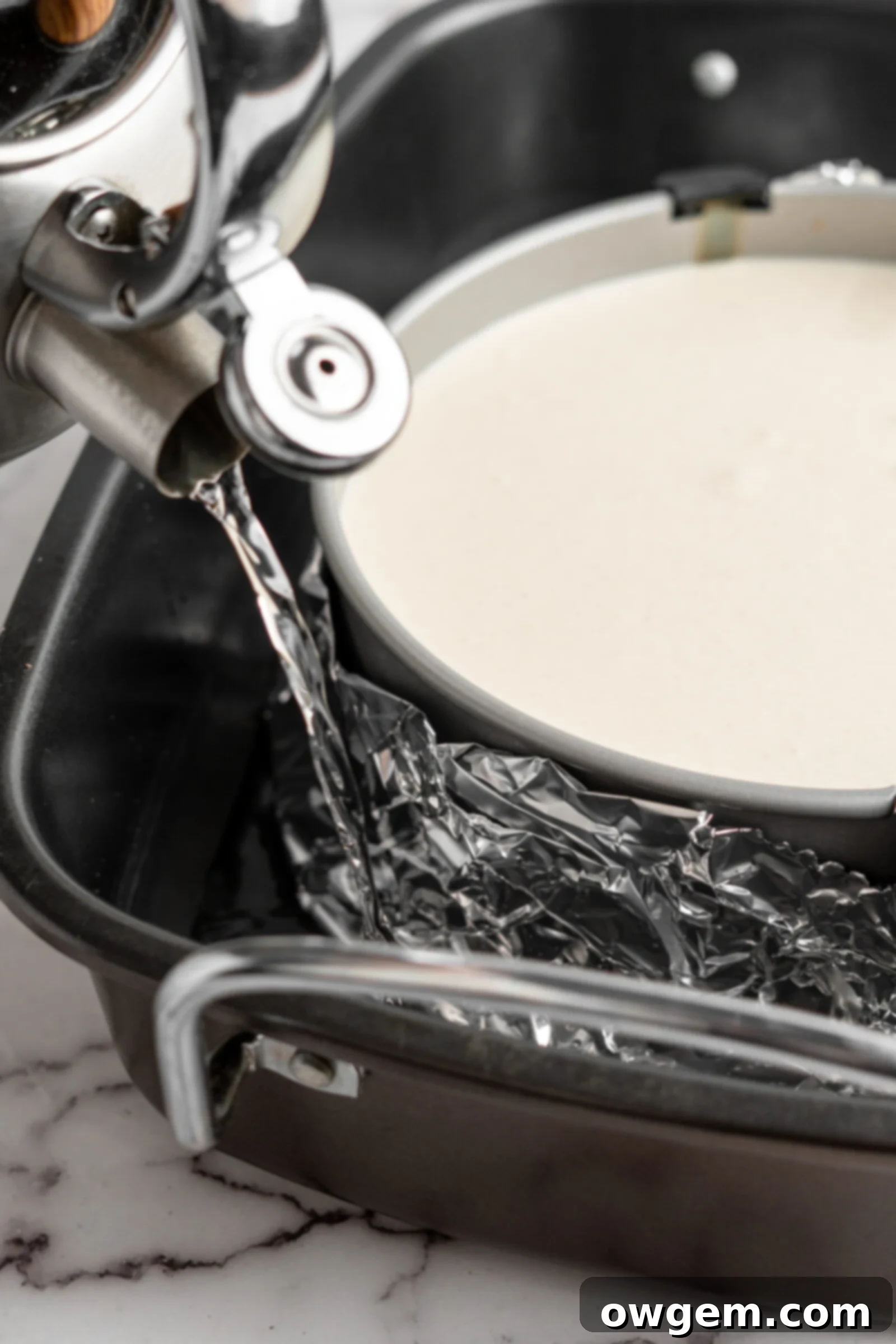
Crafting the Irresistible Caramel Pecan Topping
This warm, nutty caramel topping is what truly elevates our cheesecake from great to extraordinary. Here’s how to make it:
Begin by toasting the pecans. Place your pecans in a dry skillet over medium heat. Toast them for approximately 3 minutes, stirring occasionally, until they become lightly browned and wonderfully fragrant. This crucial step brings out their inherent nutty flavor, making them truly shine in the topping. Once toasted, immediately remove the pecans from the pan and set them aside to cool slightly. This prevents them from burning and ensures they retain their crisp texture.
Next, in the same skillet (no need to clean it), melt the unsalted butter and dark brown sugar together over medium heat. At first, it might look like the butter and brown sugar are resisting each other and won’t combine – this is perfectly normal! Keep whisking lightly and patiently. As the butter melts and the sugar dissolves, they will gradually come together to form a cohesive, bubbling sauce. Continue to cook, stirring, until the mixture is smooth and fully combined, typically just a few minutes, making sure it doesn’t scorch.
Once the butter and sugar mixture is bubbling beautifully, slowly drizzle in the heavy cream while continuously whisking. This slow addition helps create a smooth, emulsified caramel. Continue whisking until the heavy cream is fully incorporated and the sauce is uniform and creamy. Finally, remove the skillet from the heat, then stir in the previously toasted pecans, a pinch of salt (which wonderfully enhances the caramel flavor), and the vanilla extract. Mix everything together until the pecans are evenly coated. Allow the caramel pecan sauce to cool slightly for about 20-30 minutes before pouring it over the chilled cheesecake and serving. This cooling time allows it to thicken to the perfect pourable consistency and ensures it’s still beautifully warm.
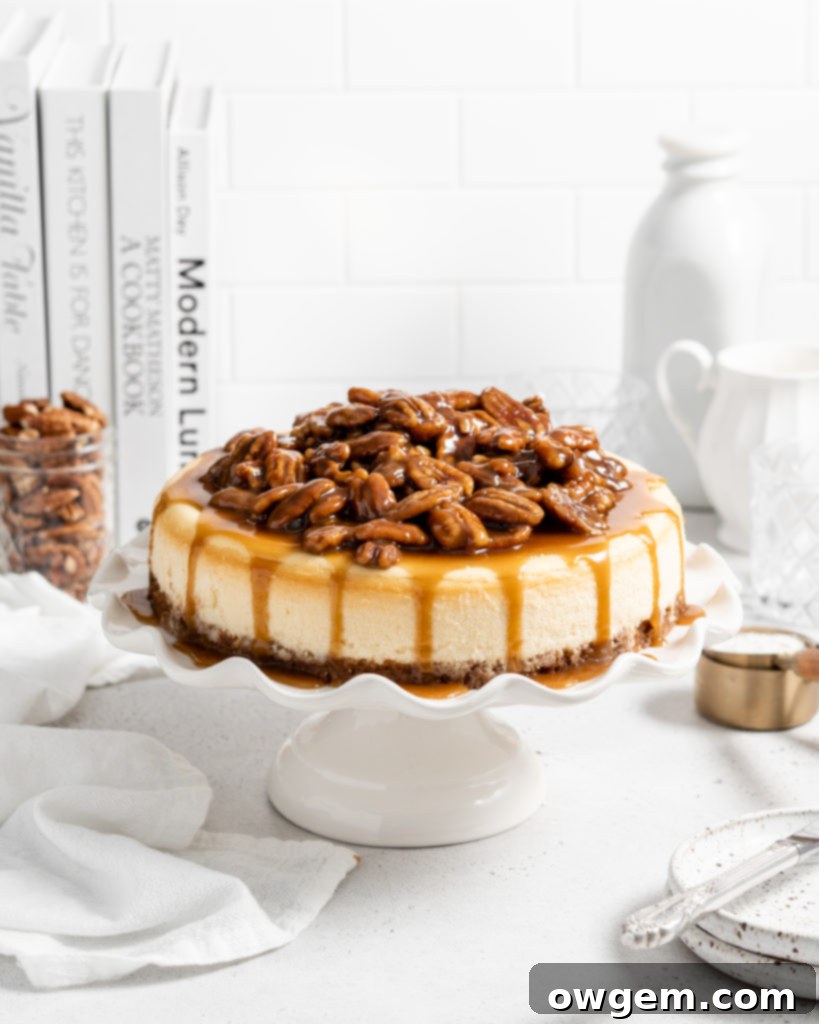
Expert Tips & Tricks for Cheesecake Perfection
Achieving a perfect cheesecake can be simple with these tried-and-true tips. Following these guidelines will help you avoid common pitfalls and ensure a beautifully smooth, crack-free, and delicious dessert.
Use softened cream cheese. This cannot be stressed enough! Cream cheese that is at a soft, room temperature state will blend effortlessly into a smooth batter. If your cream cheese is cold and hard, it will lead to lumps in your batter, and you’ll be tempted to overmix, which incorporates too much air. Too much air is the enemy of a crack-free cheesecake, so plan ahead and let it soften for at least an hour on the counter.
Always cook in a water bath. A water bath, or “bain-marie,” creates a moist, consistent cooking environment for your cheesecake. The steam from the boiling water helps the cheesecake cook gently and evenly, preventing the edges from drying out and cracking before the center is set. It also contributes to that signature silky-smooth texture, making it an essential technique for cheesecake success.
Turn the oven off when the cheesecake is still slightly jiggly. Don’t wait for the center to be completely firm. Cheesecake continues to cook from residual heat even after it’s removed from the direct heat source. You want the center to still have a slight, uniform jiggle when you turn off the oven. If it’s completely firm, it’s already overcooked, and overcooking is a primary cause of those unsightly cracks.
Allow the cheesecake to cool in a cracked oven. After turning off the oven, prop the door open slightly (with a wooden spoon, for example) and let the cheesecake cool gradually inside for about 1 to 1.5 hours. Cheesecake’s worst enemy is a drastic, sudden change in temperature. Rapid cooling causes the cheesecake to contract too quickly and unevenly, almost guaranteeing cracks. Slow cooling allows it to adjust gently.
Ensure the cheesecake is at room temperature before placing into the fridge. Similar to the gradual oven cooling, avoid moving a warm cheesecake directly into a cold refrigerator. The extreme temperature difference can shock the cheesecake, leading to further contraction and cracking. Allow it to come down to room temperature on the counter before chilling it thoroughly in the fridge for optimal setting and texture.
Use the caramel pecan sauce while still warm. The caramel pecan sauce is designed to be served warm. When cold, the butter in the caramel will solidify and turn cloudy, making it less appealing and harder to pour. Warming it gently restores its glossy, luscious texture and deepens its flavor, perfectly complementing the cool cheesecake. Plus, the contrast of warm topping on cold cheesecake is simply divine!
Use a hot knife to slice the cheesecake. For beautifully clean and sharp slices, dip a long, thin knife in hot water, wipe it clean, and then make each cut. Repeat this process for every slice. The warmth from the knife effortlessly glides through the dense, creamy cheesecake, preventing sticking and crumbling, giving you that perfect bakery-quality slice.
Always use full-fat ingredients. Cheesecakes are meant to be rich, decadent, and creamy. Using full-fat cream cheese, sour cream, and heavy cream is absolutely essential to achieve the proper velvety texture and robust flavor profile. Low-fat or non-fat alternatives simply won’t yield the same luxurious results.
Invest in a good quality nonstick springform pan. A reliable springform pan is a cheesecake baker’s best friend. A good nonstick pan ensures the cheesecake releases cleanly from the sides, reducing the stress on the cake as it cools and contracts. If the cheesecake sticks to the pan, it’s much more prone to cracking when it shrinks, so this investment is worthwhile.
Wrap the pan in foil thoroughly. When preparing your springform pan for the water bath, use at least two layers of heavy-duty aluminum foil, wrapped tightly around the bottom and sides. This is your best defense against water seeping into the crust and making it soggy. A well-wrapped pan guarantees a perfectly crisp bottom layer.
Do not overbeat the batter. Once you’ve added the eggs, mix the batter as little as possible, only until just combined. Overbeating incorporates too much air into the cheesecake batter, which then expands during baking and contracts rapidly during cooling, making the cheesecake much more susceptible to cracking and giving it an undesirable airy, spongy texture instead of a dense, creamy one.
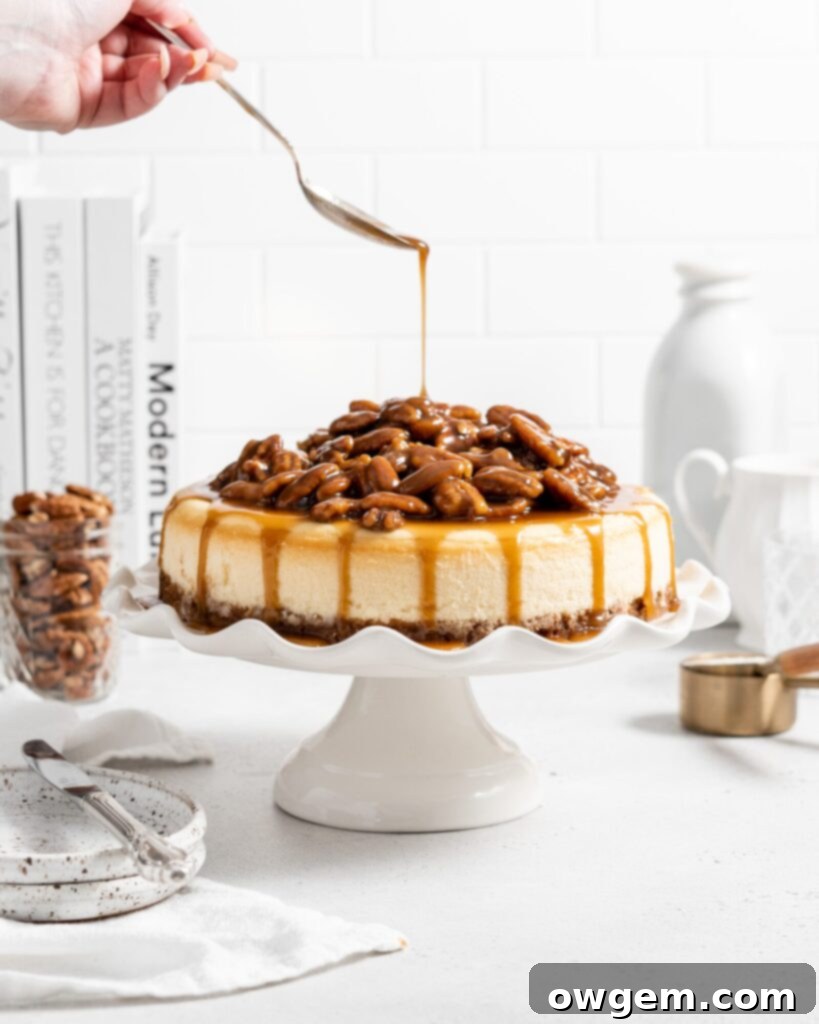
Essential Equipment for Your Cheesecake Journey
Having the right tools can make all the difference in ensuring your cheesecake-making process is smooth and successful. Here’s what you’ll need:
Cheesecake pan (Springform Pan): This is arguably the most critical piece of equipment. My absolute favorite cheesecake pan has been a game-changer for me. It’s designed to be truly leakproof, which means you don’t have to worry about water from the water bath seeping into your precious crust. Furthermore, its superior nonstick coating significantly reduces the chances of your cheesecake sticking to the sides and cracking as it cools. A good quality springform pan will ensure a beautiful, intact cheesecake every time.
Roasting pan: You’ll need a large roasting pan that is big enough to comfortably fit your 9-inch or 10-inch springform pan inside, with enough space to pour boiling water around it. The roasting pan facilitates the crucial water bath, providing even, gentle heat for your cheesecake.
Stand mixer or hand mixer: Either a stand mixer (with a paddle attachment) or a reliable hand mixer is essential for effectively mixing the cheesecake batter. These tools ensure the cream cheese is perfectly smooth and that all ingredients are thoroughly combined without overmixing, which is key to a velvety, crack-free cheesecake.
Storing Your Decadent Caramel Pecan Cheesecake
To keep your cheesecake fresh and delicious for as long as possible, proper storage is key. Here’s how to best store your caramel pecan masterpiece:
Fridge: The finished caramel pecan cheesecake can be stored in the refrigerator, loosely covered with plastic wrap or in an airtight container, for up to 4 days. For the best quality and presentation, I highly recommend storing the caramel pecan sauce separately from the cheesecake. This is because the sauce is best served warm, and its texture can change when chilled directly on the cheesecake for extended periods. When ready to serve, simply warm the desired amount of topping and pour it over individual slices or the entire cheesecake.
Freezer: If you wish to enjoy this treat later, the cheesecake (without the caramel pecan topping) freezes beautifully. Ensure the cheesecake is fully chilled and set, then remove it from the springform pan. Wrap the entire cheesecake tightly in several layers of plastic wrap, followed by a layer of aluminum foil, or place it in a freezer bag or airtight container. It can be frozen for 1-2 months. When ready to enjoy, thaw the cheesecake in the refrigerator overnight. Prepare the caramel pecan sauce fresh just before serving for the best experience.
Frequently Asked Questions About Caramel Pecan Cheesecake
A water bath, also known as a bain-marie, is a gentle cooking method. For cheesecake, it involves placing your springform pan (which is securely wrapped in foil) into a larger roasting pan. Then, you carefully pour boiling water into the roasting pan, ensuring it reaches approximately halfway up the outside of the cheesecake pan. The steam created by the hot water provides a moist and even cooking environment, preventing the cheesecake from drying out, baking too quickly, and developing cracks. It’s crucial for achieving that signature silky-smooth, creamy texture.
Yes, it is highly recommended and almost essential for optimal results. While some cheesecake recipes claim to work without a water bath, for a truly professional-looking, crack-free, and sumptuously soft caramel pecan cheesecake, a water bath ensures even cooking, helps maintain a smooth, pristine top surface, and contributes significantly to a softer, more delicate texture. Skipping this step drastically increases the risk of cracks and a drier, less desirable consistency.
Don’t despair if you’re in a hurry! While room temperature is ideal, you can quickly soften cream cheese. Cut the blocks of cream cheese into smaller cubes. Place them in a microwave-safe bowl and microwave on low power (e.g., 50%) for 15-30 second intervals, stirring well between each interval. Continue until the cream cheese is very soft and creamy, but be careful not to overheat it – it should not be hot or melted. Overheating can change its texture and affect the cheesecake batter.
Cheesecake cracks are typically caused by one of two main issues: overcooking or cooling too quickly. Overcooking makes the cheesecake dry out and pull away from the sides of the pan, leading to cracks. Cooling too rapidly (e.g., pulling it straight from a hot oven into a cold room or fridge) causes a sudden contraction that also results in cracks. To prevent this, ensure you remove the cheesecake from the oven when it still has a slight jiggle in the center, and always allow it to cool gradually first in a cracked oven, then on the counter to room temperature, before chilling in the refrigerator.
For detailed storage instructions, please refer to the ‘How to store the caramel pecan cheesecake’ section above in the article. In short, keep it covered in the fridge for up to 4 days, ideally storing the warm caramel pecan topping separately until serving.
No, for the best results, I strongly recommend sticking to full-fat ingredients. This recipe is specifically developed to achieve a rich, dense, and creamy texture that relies on the fat content of traditional dairy products. Using low-fat or nonfat alternatives will significantly alter the texture, taste, and overall quality of the cheesecake, often resulting in a less stable, drier, or rubbery consistency that won’t live up to the decadent expectation.
Yes, you can easily adapt this recipe to be gluten-free. Simply substitute regular graham cracker crumbs with a gluten-free version. Ensure all other ingredients, like vanilla extract and any other flavorings, are certified gluten-free. The rest of the recipe and baking method remain the same, allowing you to enjoy this delicious dessert regardless of dietary restrictions.
Related Cheesecake Recipes to Explore
If you loved this caramel pecan cheesecake, you might enjoy exploring some of our other delightful cheesecake creations:
Apple Spice Cheesecake
Salted Honey Cheesecake
SunButter Salted Caramel Cheesecake
Raspberry Pistachio Cheesecake
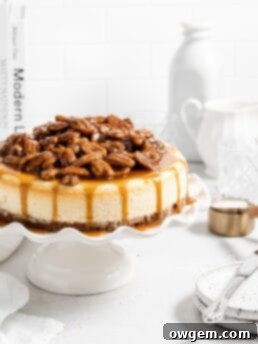
Get the Recipe:
Caramel Pecan Cheesecake
Pin
Rate
Ingredients
Graham Cracker Crust
- 1 ¾ cups Graham Cracker Crumbs
- 1/4 cup White Sugar
- 1/2 cup Unsalted Butter,, melted
Caramel Pecan Cheesecake
- 32 oz (1000g) Cream Cheese, well softened, (4 blocks of cream cheese)
- 1 ½ cups White Sugar
- 1 tbsp Vanilla
- 1 tsp Cinnamon
- 1/4 tsp Kosher Salt
- 3 Large Eggs,, at room temperature
- 2 Large Egg Yolks,, at room temperature
- 3/4 cup Heavy Cream
- 3/4 cup Sour Cream
- 1 tbsp Cornstarch
Caramel Pecan Sauce
- 3/4 cup Dark Brown Sugar
- 9 tbsp Unsalted Butter,, at room temperature
- 1/2 cup Heavy Cream
- 2 cups Pecans
- 1/2 tsp Vanilla
- 1/4 tsp Salt
Equipment
-
Stand mixer
Instructions
Graham Cracker Crust
-
Preheat the oven to 350°F. Add the graham cracker crumbs and sugar to a bowl and whisk until well combined. Pour the melted butter into the bowl, then mix with a fork, or your hands, until the butter is well dispersed and the mixture resembles wet sand.
-
Grease a 9” or 10” springform pan, then add the crust into pan and press it down evenly into the bottom. Use a flat bottom measuring cup to really compact the crust down. Place the crust into the oven to bake for 10 minutes. Remove from oven and allow to cool to room temperature.
Caramel Pecan Cheesecake
-
Turn the oven down to 325°F. Prepare the cooled springform pan (with the crust) by wrapping the bottom of the pan with 2 sheets of tinfoil, then set aside.
-
In a large mixing bowl, or stand mixer, add the soft cream cheese and beat on low until it looks soft and creamy – about 2 minutes. Add the sugar, vanilla, cinnamon and salt, and beat on low until very creamy – 3-4 minutes. While still beating on low, add the eggs and yolks, one at a time, ensuring that each egg is fully incorporated before adding the next, ensuring that you are also scraping at the bowl as necessary.
-
Add the heavy cream and sour cream, then beat on low until the cheesecake filling looks creamy, smooth, and uniform. Finally, add in cornstarch then beat on low one last time on low until the corn starch is well-combined.
-
Pour the filling over top of the cooled crust in the springform pan, then place the cheesecake into a large roasting pan. Pour enough boiling water into the roasting pan so that it reaches about halfway up the outside of the springform pan. Place into the oven to bake for 1 hour and 30 minutes. When the cheesecake is done it should still be a little jiggly in the centre.
-
When done, lightly crack the oven open to allow the cheesecake to slowly cool for about an hour and a half. After an hour and a half, remove the cheesecake from the oven and water-bath and place onto the counter to cool to room temperature. Once at room temperature, wrap with plastic wrap and place into the fridge for at least 6 hours or preferably overnight.
Caramel Pecan Sauce
-
In a skillet over medium heat, begin toasting the pecans in the pan for 3 minutes or until lightly browned and fragrant. After, remove the pecans from the pan, and set aside for later.
-
Add the brown sugar and butter to the skillet. Heat while whisking, until the sauce comes together nicely and begins to boil.
-
Next, while whisking, slowly drizzle in the heavy cream. After all of the cream has been added and is well-combined, remove from the heat, then add in the toasted pecans, vanilla, and salt. Fold everything together, then allow the sauce to cool for 20 – 30 minutes.
-
After 20 – 30 minutes, pour the warm caramel pecan sauce over the cheesecake and serve immediately.
